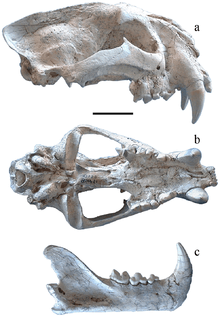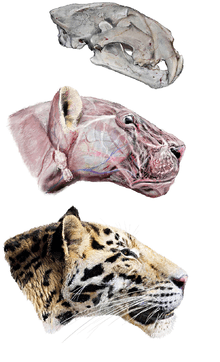Panthera zdanskyi
| Panthera zdanskyi | |
|---|---|
 | |
| Holotype skull | |
| Scientific classification | |
| Kingdom: | Animalia |
| Phylum: | Chordata |
| Class: | Mammalia |
| Order: | Carnivora |
| Suborder: | Feliformia |
| Family: | Felidae |
| Subfamily: | Pantherinae |
| Genus: | Panthera |
| Species: | †P. zdanskyi |
| Binomial name | |
| Panthera zdanskyi Mazák, Christiansen & Kitchener, 2011 | |
The Longdan tiger or Panthera zdanskyi is an extinct species of pantherine known from the Gansu province of northwestern China.[1]
Etymology
Panthera zdanskyi was first named by Ji H. Mazák, Per Christiansen and Andrew C. Kitchener in 2011. The specific name honors the Austrian paleontologist Otto A. Zdansky for his contributions to the understanding of Neogene Chinese fossil carnivorans.[1]
Description

Panthera zdanskyi is known from the holotype BIOPSI 00177, a nearly complete skull and mandible and from the paratype IVPP 13538, a rostrum, premaxilla and maxilla and much of the dentition, originally referred to Panthera palaeosinensis. It was collected in 2004 in the east slope of Longdan, south of Dongxiang Autonomous County from the Lower Pleistocene Equus fauna, dating to the Gelasian stage of the earliest Pleistocene, about 2.55–2.16 million years ago. It is the oldest known complete pantherine skull ever found.[1]
Phylogeny
The cladogram below follows Mazák, Christiansen and Kitchener (2011).[1]
| Pantherinae |
| ||||||||||||||||||||||||||||||||||||||||||||||||||||||
See also
References